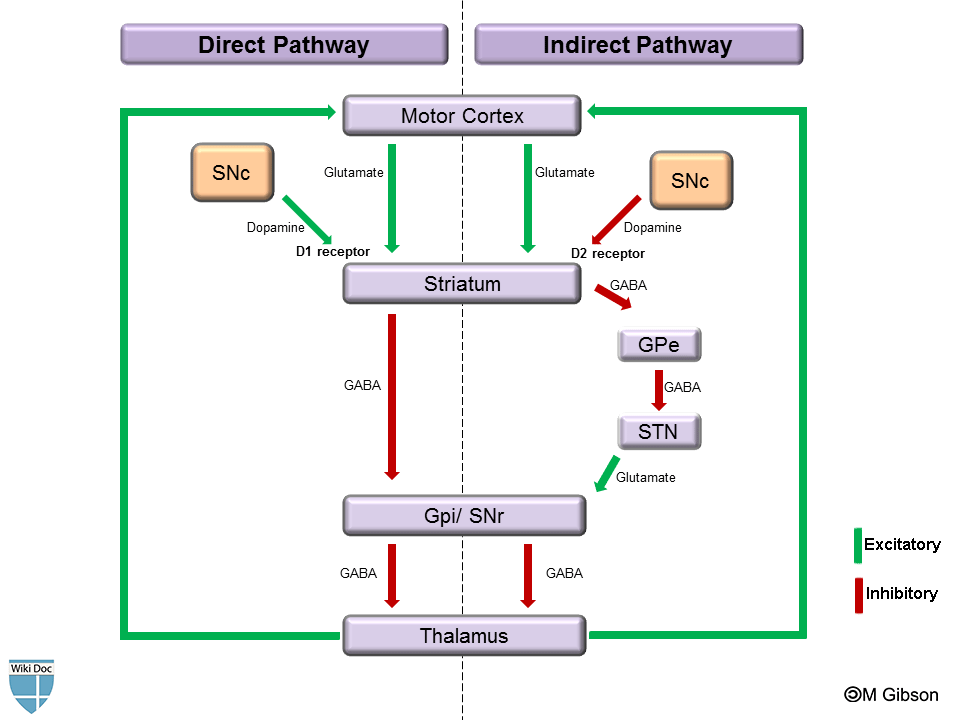WBR0611
| Author | [[PageAuthor::Rim Halaby, M.D. [1]]] |
|---|---|
| Exam Type | ExamType::USMLE Step 1 |
| Main Category | MainCategory::Pathophysiology |
| Sub Category | SubCategory::Neurology |
| Prompt | [[Prompt::A 62-year-old male patient complains of a bilateral tremor in his hands. The tremor initially started in his right hand and then became bilateral. The tremor is similar to rolling a cigarette between the fingers and it is mostly apparent when the patient puts his hands on the table without motion. The tremor decreases when he moves his hands and disappears when he sleeps. Which of the following explains the underling pathological mechanism of the patient’s condition?]] |
| Answer A | AnswerA::Depletion of dopamine leading to less stimulation of the direct pathway via D1 receptors |
| Answer A Explanation | [[AnswerAExp::Dopamine, released from substantia nigra compacta, binds to D1 receptors and stimulates the direct pathway leading to increased motion. In Parkinson's disease, dopamine depletion causes less stimulation of the direct pathway via D1 receptors.]] |
| Answer B | AnswerB::Depletion of dopamine leading to less stimulation of the indirect pathway via D1 receptors |
| Answer B Explanation | [[AnswerBExp::Dopamine, released from substantia nigra compacta, binds to D2 receptors and inhibits the indirect pathway leading to increased motion. In Parkinson's disease, dopamine depletion causes less inhibition of the indirect pathway via D2 receptors.]] |
| Answer C | AnswerC::Depletion of dopamine leading to less stimulation of the direct pathway via D2 receptors |
| Answer C Explanation | [[AnswerCExp::Dopamine, released from substantia nigra compacta, binds to D1 receptors and stimulates the direct pathway leading to increased motion. In Parkinson's disease, dopamine depletion causes less stimulation of the direct pathway via D1 receptors.]] |
| Answer D | AnswerD::Depletion of dopamine leading to less inhibition of the direct pathway via D1 receptors |
| Answer D Explanation | [[AnswerDExp::Dopamine, released from substantia nigra compacta, binds to D1 receptors and stimulates the direct pathway leading to increased motion. In Parkinson's disease, dopamine depletion causes less stimulation of the direct pathway via D1 receptors.]] |
| Answer E | AnswerE::Depletion of dopamine leading to more inhibition of the indirect pathway via D2 receptors |
| Answer E Explanation | [[AnswerEExp::Dopamine, released from substantia nigra compacta, binds to D2 receptors and inhibits the indirect pathway leading to increased motion. In Parkinson's disease, dopamine depletion causes less inhibition of the indirect pathway via D2 receptors.]] |
| Right Answer | RightAnswer::A |
| Explanation | [[Explanation::There are two pathways in the basal ganglia that controls the fine tuning of motor activities: the direct excitatory pathways and the indirect inhibitory pathway. Dopamine, released from substantia nigra compacta, binds to D1 receptors and stimulates the direct pathway and also binds to D2 receptors inhibiting the indirect pathway. The outcome is increasing motor activity through both pathways.
The patient presents with pill-rolling tremor present at rest and absent upon motion and sleep, which is characteristic of Parkinson's disease. Parkinson's disease presents with resting tremor, rigidity, bradykinesia and postural instability that are resulting from depletion of dopamine in the substantia nigra compacta. When dopamine decreases, there will be less activation of the direct pathway through D1 receptors and less inhibition of the indirect pathway through D2 receptors which result in decreased motion and symptoms of Parkinson's disease. Shown below is an image depicting the direct and indirect pathways in the basal ganglia.  Educational Objective: Dopamine is normally released from the substantia nigra compacta and then binds to D1 receptors to stimulate the direct pathway, thereby leading to increased motion. This mechanism is perturbed in Parkinson's disease. |
| Approved | Approved::No |
| Keyword | WBRKeyword::Resting tremor, WBRKeyword::Parkinson's disease, WBRKeyword::Basal ganglia, WBRKeyword::Dopamine |
| Linked Question | Linked:: |
| Order in Linked Questions | LinkedOrder:: |